Wednesday, April 30. 2008
 More here. More here.
(h/t, Ace)
Tuesday, April 29. 2008
Springtime, and amore is in the air. (h/t, Theo) 
Monday, April 28. 2008
 I think so, and Climate Skeptic agrees: I think so, and Climate Skeptic agrees:
Observe today how little of the discussion is about anything other than climate. There are still many environmental issues in the world that can be improved by the application of man's effort and technology -- unfortunately, climate is the least of these but the issue getting the most attention. Consider how the global warming panic has sucked the oxygen out of the environmental movement. Ten years from now, I predict that true environmentalists will be looking back on the hysteria over trace amounts of CO2 in the atmosphere as a huge setback for real environmental progress.
As readers know, we are old-time Conservationists here. We believe in National Parks, State Parks, nature preserves, farmland protection, habitat protection, species protection, zoning, "open space", clean rivers and waters, unpolluted air, and we do not approve of the government subsidizing real estate developers and urban sprawl by building highways to nowhere. The Audubon Society came into being to protect Egrets. The photo above of an American Egret in CT, with his breeding plumage (sent in by a reader last week), shows the reason. At the turn of the century, those breeding-season plumes were all the rage for decorating lady's hats. Thus our egrets - the American and the Snowy in particular - were hunted almost to extinction. That is called "unsustainable use." The same applied to the market-gunning and netting of waterfowl - and the Passenger Pigeon. Of necessity, we now have hunting laws, hunting seasons, wildlife refuges, and protected species. Thus we are not Libertarian when it comes to land-use and unsustainable and irreversible exploitation of wildlife or wildlife habitat. The Conservation Movement of John Muir and Teddy Roosevelt had to become politicized, because laws were required in the presence of competing interests: witness, nowadays, the political conflicts in MA and in Europe around the efforts to enforce sustainable fish harvests. We simply try to be rational about it all. For example, we have no problem with oil drilling in ANWAR or off the Florida coast (as the Cubans and Chinese are doing). We have no problem with responsible logging, which effectively mimics the effects of natural wildfire on forest succession. We love to hunt and fish, and do so responsibly and sportingly. We think the earth probably has more than enough people on it. We favor nuclear power for reasons of energy independence and because it's the closest thing to a free lunch after compound interest. We feel that biofuels are a lousy idea for many reasons. 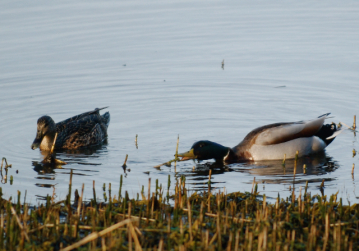 At the risk of sounding corny, we believe in good stewardship of our inheritance. At the risk of sounding corny, we believe in good stewardship of our inheritance.
What's irrational? The Green Movement is irrational. Most of it represents feel-good ideas that are hooey: symbolic hooey that is meant to make people feel virtuous while accomplishing nothing. Witness the lightbulb craze, "organic" vegetables, "recycling" plastic bottles (totally energy-inefficient), or hybrid cars (which do nothing "for the planet" but which are great on gas mileage). It's empty vanity and fashion, and nothing more (for an example, see this foolish agonizing piece by Michael Pollan, who has caught a bad case of the vain and guilt-ridden sanctimony of the "I can make a difference" disorder). Pure organic pixie dust for the latte liberals. The CO2 obsession is similarly irrational, and, deep down, everybody must know it. It is irrational because it is futile, regardless of whether there is any current warming, and regardless of whether there is any man-made warming. (We suspect that it is long-term cooling.) As Steyn said yesterday at NRO: Whether or not there’s very slight global cooling or very slight global warming, there’s no need for a “war” on either, no rationale for loosing a plague of eco-locusts on the food supply. So why be surprised that totalitarian solutions to mythical problems wind up causing real devastation? As for Time’s tree, by all means put it up: It helps block out the view of starving peasants on the far horizon.
If anybody thinks the Chinese, the Russians, and, eventually, Africa, intends to stop building fossil fuel power plants, they are dreaming. If anybody thinks wind power will ever be more than a drop in the bucket - even if subsidized as it is - is dreaming. And those who want (more) "carbon taxes" just want another cover, another excuse, to take more of our money. They can have more "carbon tax" if they reduce my income tax to compensate. Everybody wants more power, and as cheap as possible, because power is the wonderful stuff that makes our modern civilized, efficient and lazy lives possible. The rapidly-developing world understandably wants more of it. Somebody will need to pry my Stihl saw - and my computer - from my cold dead hands. So, to meander back to my main topic, I agree with Coyote that the CO2 frenzy and the other trendy Green frenzies have "drained the oxygen" from a Conservation movement which has many other compelling areas in which it can be, and should be, effective. And, yes, I do believe that many of those Greenies are motivated by a Socialist agenda using "Gaia" as a front. I will believe their sincerity when they quit driving and flying. However, their socialist-totalitarian streak, plus their wackiness and scolding, have damaged rational conservation goals via guilt by association. On the other hand, I do favor the use of local, state and federal powers (and especially some non-profits which do the same things free from political considerations) for the conservation goals which are important to me, which I believe to be rational, and which I like to believe contain no ideological agenda but which certainly contain a moral and practical agenda: we do not wish to hand down a planet covered with asphalt and oceans without Codfish. Some things - maybe just a very few precious things - should be more important than freedom and free markets, but that's where the political debates begin, isn't it? That is the line of scrimmage. On the "values" scale, we rank individual freedom at the top of the list, but, like everybody, we also have competing values, morals, and interests.
Friday, April 25. 2008
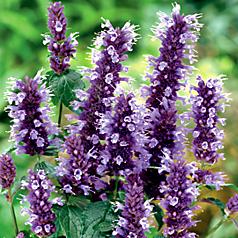 We enjoy seeing our local Ruby-Throated Hummingbirds buzzing around, and we plant things that they like. We enjoy seeing our local Ruby-Throated Hummingbirds buzzing around, and we plant things that they like.
Wayside lists 56 varieties for them. Butterflies tend to like similar plants. Gardens without hummingbirds and butterflies feel sterile. Photo: An Agastache (Hyssop).
Thursday, April 24. 2008
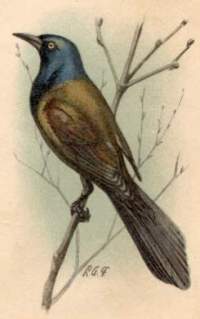 Scott at Powerline has a good grip on the penis stories. Honestly, I would not eat a Reindeer's Johnson if you paid me, but maybe I am homophobic or something. Scott at Powerline has a good grip on the penis stories. Honestly, I would not eat a Reindeer's Johnson if you paid me, but maybe I am homophobic or something.
Or maybe I just feel bad for all those poor Reindeer who are now running around the tundra without their equipment. Speaking of the Noble Male Member, I was entertained by some hot Purple Grackle (aka Common Grackle) romance on my lawn this morning. The male does quite a display for the lady: he hunches up his shoulders, splays his wings, and raises a dramatic iridescent ruff of feathers on his neck as he struts before her: he tries to make like a Bird of Paradise. Then he hops on top of her for about 4 seconds. He did that twice in five minutes. Afterwards, she did a shake to compose her feathers and her excited feminine heart, no doubt - and he walked off cheerfully, with a bit of a swagger, looking for bugs in the grass. I think it was consensual, but she did seem a little put out by it all. Women are sometimes like that.
Wednesday, April 23. 2008
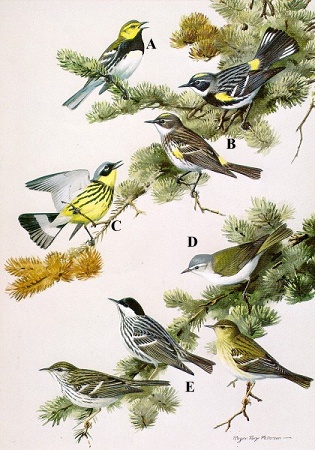 With Spring warbler season upon us, it seemed timely to note that Nikon has finally come up with a binocular that can compete with the Germans. With Spring warbler season upon us, it seemed timely to note that Nikon has finally come up with a binocular that can compete with the Germans.
Here's the 7X42. There is also an 8X32. Image: A few Spring Warblers, by Peterson
Friday, April 18. 2008
Environmentalism, so called, is essentially an urban religion. Like Lenin organizing agriculture from an office, environmentalists have a bizarre worldview based on never really knowing much about the subject at hand. Most environmentalists got all they ever learned about the real world from Bambi. There are many conservators of nature. The only people I ever met who understand anything about nature are hunters and farmers. I never met an academic whose opinion about the natural world was worth a fig.
A person that has killed another beast in the wild, and eats it, has smelled the very musk on the beast, and felt the last shivers of its life ebb away. A hunter knows a lot about a deer you don't. And they didn't do anything that wasn't going to happen to that creature anyway. There are no nursing homes in the forest, and eventually every beast loses a step on the manifold forces arrayed against it. Some sooner than later, as we will see.
A goldfish would eat you if it could get you in his mouth. That's all you need know about Nature. Go out in it, and have something real to do with it. Life and death; or a test of will, anyway. You can never respect it if you don't know about it. And remember it's still as cruel and remorseless as God made it in the first place.
Tuesday, April 15. 2008
The reintroduction of Moose to Scotland. Very cool. But why do they have to be fenced? Battles over wolves in the American West.
It's Skunk Cabbage time in New England. They are the earliest of marsh plants, producing their fleshy flower (in photo) before they produce their abundant cabbagy and funky-smelling leaves. Remarkable fact about these plants: They are thermogenic. That's how they can punch through snow and ice so early in Springtime. 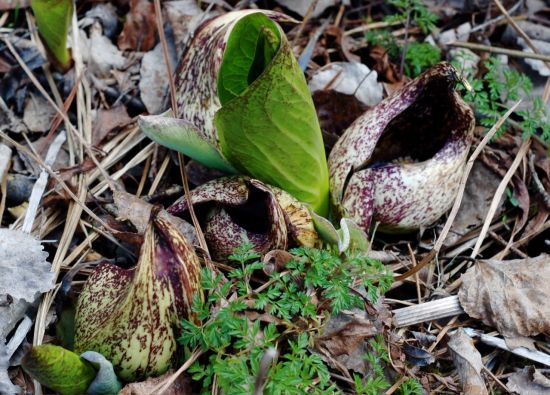
Tuesday, April 8. 2008
Just grow them, dry them out, punch a 1" hole in them, and hang 'em in a tree. Instant House Wren house. A house is not a home unless you have these members of the chattering class around. (Ours haven't arrived yet this Spring. Global cooling is to blame.)
Monday, April 7. 2008
Thanks for the photo, Chris 
Tuesday, April 1. 2008
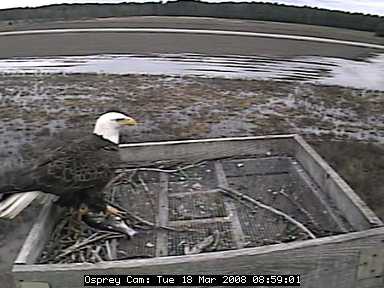 As readers know, The Friends of Blackwater NWR in Cambridge, MD have two live BirdCams, one on a Bald Eagle nest: Click here: Friends of Blackwater NWR - Bald Eagle Cam (I only see one little eaglet in the nest) and the other on an Osprey nest: Click here: Friends of Blackwater NWR - Osprey Cam. As readers know, The Friends of Blackwater NWR in Cambridge, MD have two live BirdCams, one on a Bald Eagle nest: Click here: Friends of Blackwater NWR - Bald Eagle Cam (I only see one little eaglet in the nest) and the other on an Osprey nest: Click here: Friends of Blackwater NWR - Osprey Cam.
Photo is an eagle with a fish, perched on a not-yet used Osprey nest platform.
Thursday, March 27. 2008
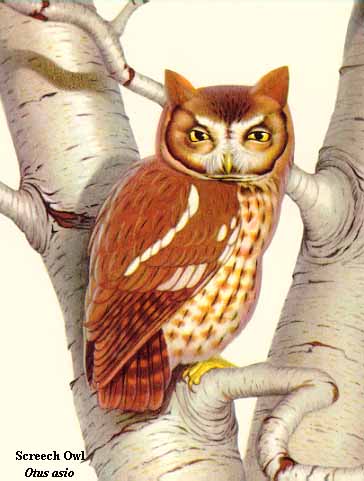 I heard one whinny at around 5 AM on Good Friday. It's a treat to hear, and I hope that it means we will have a nesting pair of these pigeon-sized little owls in the area. I heard one whinny at around 5 AM on Good Friday. It's a treat to hear, and I hope that it means we will have a nesting pair of these pigeon-sized little owls in the area.
Maybe I should put up a Screech Owl nest box, but there are so many trees with holes around here that it's probably not necessary. I have never had to chase them out of any of my Wood Duck boxes, but they are known to occupy them. I had neighbors who had a pair for years using their Wood Duck house on a tiny island in a pond (which seemed reckless of the owls, to me). You could see the owl's face, sometimes, sunning itself in the hole. It's unusual to see them. Practically speaking, the only way you would know that they are around is by hearing them at night. These owls do not mind suburbia at all, and are probably breeding in all five boroughs of New York City. These nocturnal birds are not rare everywhere east of the Rockies, and come in Red, Brown, and Grey races. They do not screech; they have a trill and a ghostly whinny. One more of those eery night-time sounds. Here are their calls. Read the detailed CLO entry on the Eastern Screech Owl here.
Monday, March 24. 2008
The piece in the National Post begins: They drift along in the worlds' oceans at a depth of 2,000 metres -- more than a mile deep -- constantly monitoring the temperature, salinity, pressure and velocity of the upper oceans. Then, about once every 10 days, a bladder on the outside of these buoys inflates and raises them slowly to the surface gathering data about each strata of seawater they pass through. After an upward journey of nearly six hours, the Argo monitors bob on the waves while an onboard transmitter sends their information to a satellite that in turn retransmits it to several land-based research computers where it may be accessed by anyone who wishes to see it. These 3,000 yellow sentinels --about the size and shape of a large fence post -- free-float the world's oceans, season in and season out, surfacing between 30 and 40 times a year, disgorging their findings, then submerging again for another fact-finding voyage.
Read the whole thing and find out what they are telling us.
Thursday, March 13. 2008
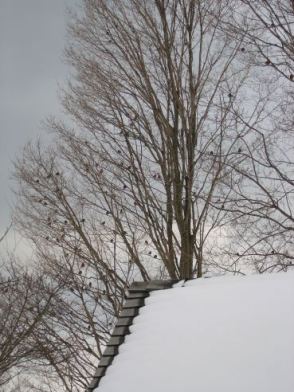
Turdus in the snow: What an ugly name for almost everyone's favorite American Bird bird (except for the Ruffed Grouse), our good buddy Turdus migratorius. The Robin. We have small flocks of them all winter here, living on berries and old fruit, but they are on the move north now, and we see more - mainly flocks of males. Yesterday I heard their spring song for the first time. Today we have snow and that spring song has been put on hold. Did you know that they used to be hunted for food? And that they are really woodland thrushes who have found a way to adapt to suburbia? Learn more about a familiar friend: American Robin Photo: Sugar maple full of Robins, March 2007.
Thursday, March 6. 2008
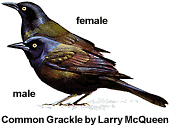 Our first migratory wave of flocks of Common Grackles and Robins arrived here this week from their winter in the southern US. We have spoken of Turdus Migratorius (Robin) here in the past, but not about the Common Grackle, who has been extending his range from the Mississippi Valley across the US east of the Rockies, and north into Canada. Our first migratory wave of flocks of Common Grackles and Robins arrived here this week from their winter in the southern US. We have spoken of Turdus Migratorius (Robin) here in the past, but not about the Common Grackle, who has been extending his range from the Mississippi Valley across the US east of the Rockies, and north into Canada.
A flock of these large wetlands-loving (but highly adaptable) blackbirds will empty your bird feeder in a few hours, accompanied by their loud screeching and squawking. Our friend Sippican sends this photo of a migratory flock in his yard on the Massachusetts coast last September: 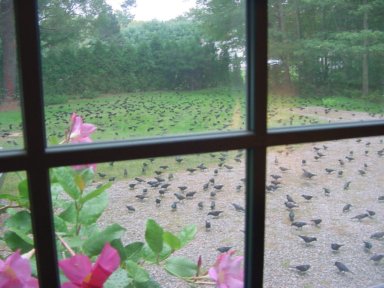
You can read about the Common Grackle here.
Saturday, February 23. 2008
This is a reposting from 2006, prompted by a post by Surber about the dramatic resurgence of the wolf populations in the northern Rockies. Also related to the Crichton video posted today. 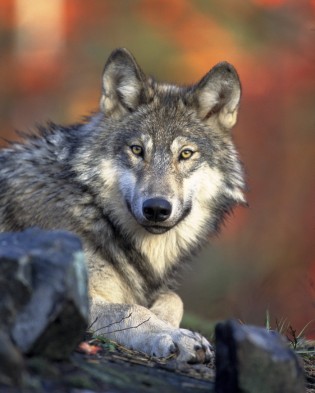 The ways that ecological interactions take place is always fascinating to me, and unpredictable. The return of wolves to Yellowstone Park is a case study. The ways that ecological interactions take place is always fascinating to me, and unpredictable. The return of wolves to Yellowstone Park is a case study.
Wolves kill more elk, balancing the elk population and driving the elk to safe zones, thus permitting the return of normal willow growth along river edges, thus cooling and stabilizing rivers resulting in bigger trout, and happy songbirds, and generally more biodiversity. And the wolves kill coyotes, thus there are more fox and mice and little critters, and more and happier hawks. Sadly, a parvovirus from domestic dogs threatens the 170 Yellowstone wolves. I guess no-one brought them in for their shots. "Apex predators" are a key piece of any ecological puzzle. I'd like to see our native Timber Wolf returned to New England, along with the Elk who used to live in the Northeast. It would solve the deer infestation and the coyote infestation, and might reduce the number of cats and dopey little ankle-biter dogs in suburbia, too. Politically, it might be tough - can you imagine running for state office with a campaign promise to return wolves to Pittsfield, MA? But maybe they will come under their own steam, the way the coyotes did - which were never native to the Northeast and which cannot take on a whitetail deer. Story in the Science Times. A Wolf website here.
Yesterday: 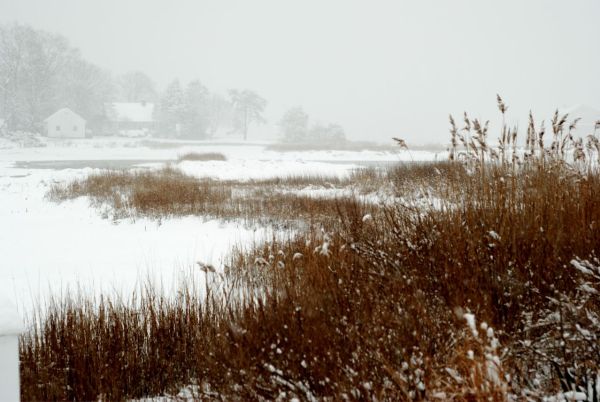
Friday, February 22. 2008
Beautiful snowy day. I have only seen the usual suspects: Blue Jay, Mourning Dove, Song Sparrow, White Throated Sparrow, SC Junco, Cardinal, BC Chickadee, WB Nuthatch, Tufted Titmouse, Downy Woodpecker, Red-bellied Woodpecker. Somebody around must be offering Niger seed (which is not really thistle seed) because I haven't seen any Goldfinches. Hoping for something exciting to come by, like maybe a California Condor or a Dodo. 
Friday, February 15. 2008
Large birds of prey lay their eggs early. A nest at Blackwater Refuge in Maryland already has two eggs. The Live Eagle Cam is here. A friend of a friend took this photo of eaglets in the Adirondacks two springs ago: 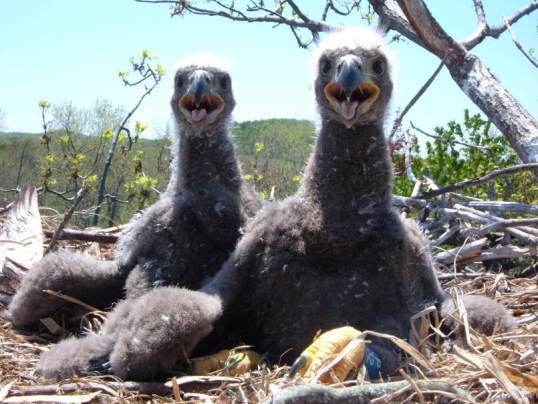
Wednesday, February 13. 2008
Yesterday's snowy evening in Yankeeland. We love our snowfalls. 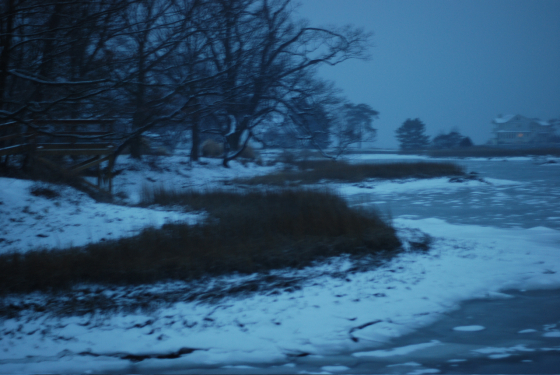
Sunday, February 10. 2008
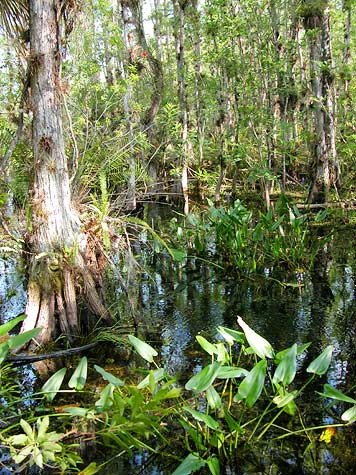 I once visited the Everglades in April, and it was really too late in the season: the wintering birds had begun to move north, and the dark swarms of attacking skeeters, especially early and late in the day, were a sight to behold. I once visited the Everglades in April, and it was really too late in the season: the wintering birds had begun to move north, and the dark swarms of attacking skeeters, especially early and late in the day, were a sight to behold.
Marshes are more full of life than any other sort of geography, which is probably why they appeal so much to me. Despite the skeeters, for birders there is nothing better. Sad that I never saw a Snail Kite, though. For your nature trips, the NY Sun agrees that winter is best for the 'glades. Photo: Big Cyress National Preserve in the Everglades.
Thursday, February 7. 2008
Even if you aren't scouting deer for hunting, heat- and motion- detecting cameras can tell you a lot about what lives out there. This photo came from some deer hunter's motion sensor camera in Montana. 
Sunday, February 3. 2008
Photo by a friend, reposted from winter 2005: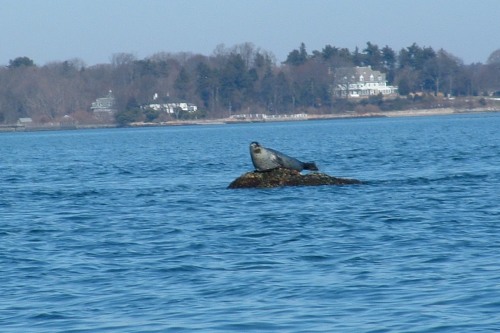 A happy Harbor Seal in Long
Island Sound, off the CT shore, in January. Thanks for the nice photo. These seals will start heading back down to Maine and other northern parts soon.
Friday, January 25. 2008
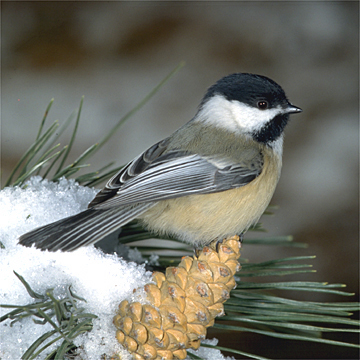 Sometimes it is good to consider some of the most familiar things in life that we take for granted, like the Chickadee. Sometimes it is good to consider some of the most familiar things in life that we take for granted, like the Chickadee.
This cute little non-migratory northern bird is known to everyone, especially from his wintertime visits to bird feeders, where he prefers sunflower seeds. He can be easily habituated to take seeds off of your palm if you stand still and have some patience. Most of the time, though, he eats bugs and bug larvae by foraging through leaves and bark in woods and woodland edges. How often do you see them in the summertime? They are still here. They will nest in any little secret hiding place or tree-hole, and will use small nest-boxes. They are loyal to their mates, probably 'til death. They are known to hide food for later, and supposedly are able to find it. Their typical "chickadee-dee-dee" call is replaced, in springtime, with a sweet "fee-beeee" which we will begin to hear as the days grow longer. You can learn more about these delightful birds here and here.
|


 More
More 
 I think so, and
I think so, and  At the risk of sounding corny, we believe in good stewardship of our inheritance.
At the risk of sounding corny, we believe in good stewardship of our inheritance.  We enjoy seeing our local
We enjoy seeing our local  Scott at Powerline has a
Scott at Powerline has a  With Spring warbler season upon us, it seemed timely to note that Nikon has finally
With Spring warbler season upon us, it seemed timely to note that Nikon has finally 

 As readers know, The Friends of Blackwater NWR in Cambridge, MD have two live BirdCams, one on a Bald Eagle nest:
As readers know, The Friends of Blackwater NWR in Cambridge, MD have two live BirdCams, one on a Bald Eagle nest:  I heard one whinny at around 5 AM on Good Friday. It's a treat to hear, and I hope that it means we will have a nesting pair of these pigeon-sized little owls in the area.
I heard one whinny at around 5 AM on Good Friday. It's a treat to hear, and I hope that it means we will have a nesting pair of these pigeon-sized little owls in the area. 
 Our first migratory wave of flocks of Common Grackles and Robins arrived here this week from their winter in the southern US. We have spoken of Turdus Migratorius (Robin) here in the past, but not about the Common Grackle, who has been extending his range from the Mississippi Valley across the US east of the Rockies, and north into Canada.
Our first migratory wave of flocks of Common Grackles and Robins arrived here this week from their winter in the southern US. We have spoken of Turdus Migratorius (Robin) here in the past, but not about the Common Grackle, who has been extending his range from the Mississippi Valley across the US east of the Rockies, and north into Canada.
 The ways that ecological interactions take place is always fascinating to me, and unpredictable. The return of wolves to Yellowstone Park is a case study.
The ways that ecological interactions take place is always fascinating to me, and unpredictable. The return of wolves to Yellowstone Park is a case study. 


 I once visited the Everglades in April, and it was really too late in the season: the wintering birds had begun to move north, and the dark swarms of attacking skeeters, especially early and late in the day, were a sight to behold.
I once visited the Everglades in April, and it was really too late in the season: the wintering birds had begun to move north, and the dark swarms of attacking skeeters, especially early and late in the day, were a sight to behold.

 Sometimes it is good to consider some of the most familiar things in life that we take for granted, like the Chickadee.
Sometimes it is good to consider some of the most familiar things in life that we take for granted, like the Chickadee.